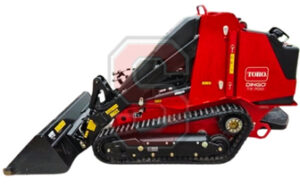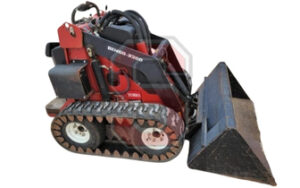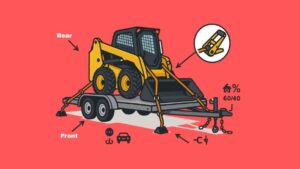There are days when the biggest loader in the yard is not the moneymaker. Crews win jobs because they finish work where heavy machines simply do not fit, do not turn, or leave damage that costs more than the revenue. The lightest skid steer, a truly narrow skid steer, or one of the compact track options opens gates, protects turf, slips through interior doorways, and rolls onto trailers without flirting with weight limits. This guide explains when light and narrow are the right call, how to compare small frames with the smallest track loader choices, and how to answer the question many buyers ask out loud on the lot. What size skid steer do I need for the work I actually sell.
Why lightest and narrowest sometimes win
A small frame loader looks underbuilt until the site forces a choice. There is a narrow gate, a fragile courtyard, a basement ramp, or a sidewalk with weight limits marked in paint. In these conditions the lightest skid steer takes a job that a heavy mid frame would lose. Light machines cut mobilization costs, reduce damage claims, and allow crews to keep moving when weather softens subbase. Narrow stance also reduces rework. If a loader fits the aisle in one pass, you do not spend time cleaning edges with hand tools.
There is also the discipline of transportation. A lighter machine on a legal trailer behind a standard truck can make two stops before lunch. A heavy loader that needs a larger trailer and a different driver sits more hours. If your first hour is always travel, the time and cost to move a small machine often beats the time and cost to move a big one. The job finishes sooner and the crew gets to the next invoice before traffic builds.
Right sizing is not about pride. It is about job mix, surfaces you drive on, and how often gates, doors, and ramps tell you what you are allowed to bring.
Turf sidewalks interiors and trailer limits
Think about where rubber meets the ground. A narrow skid steer with the correct tires or tracks will cross turf with less scarring and less sink. On sidewalks a compact loader stays on the slab and avoids breaking edges because axle loads are lower. Inside buildings or greenhouses, a small bobcats class machine can make a turn in an aisle that would trap a larger frame. When a customer asks for proof you will not wreck surfaces, a small machine is the promise you can keep.
- Turf protection improves as ground pressure drops and as turns get smoother. Light loaders make both easier to achieve without expensive matting.
- Sidewalks do not forgive point loads at edges. A narrow machine that stays centered avoids phone calls about broken corners.
- Interior work is not a place for guesswork on fumes and clearances. A compact loader with clean exhaust routing, low height, and predictable travel makes the work safer for everyone on site.
- Trailer limits matter on busy weeks. If you are often one strap and five minutes from rolling, you will take more jobs and miss fewer windows between storms.
Smallest track loader and compact options
Track undercarriages change how a compact machine behaves. The smallest track loader will float on soft ground where a small wheeled loader would dig holes. Tracks lengthen the wheelbase and calm the machine when you carry a load at low height. Compact track models also protect concrete and pavers with the right lug pattern. If you work near pools, gardens, courtyards, and synthetic turf, a narrow compact track loader can be the only answer that meets the job’s rules.
There are several versions to consider. Stand on mini track loaders fit through narrow gates and squeeze down basement ramps. Sit in compact track loaders give operators a real cab, heat and air, and better visibility for long days. Some narrow skid steer frames can accept over the tire tracks for seasonal work. All three answers aim at the same problem. Move material and power attachments in tight space without tearing the site apart.
- Stand on minis win on gateway width and fast on off cycles. Operators hop off to handle material and hop back on without climbing into a cab.
- Small sit in track loaders win when hours are long and the work demands cab comfort, defrost, and wipers. Productivity climbs when operators are warm and dry.
- Over the tire tracks can be a bridge solution for a small wheeled loader during wet seasons. They add stability and flotation but change turning behavior and transport weight.
Smallest does not mean weakest. Pair the right attachment to the auxiliary flow you have and you will finish sooner than a larger loader stuck at a gate.
Lightest Skid Steer Models
Model comparison to pick the right size
Every skid steer comparison needs the same three pages. A work mix page that lists what you do most, a site constraints page that lists gates, doors, and surfaces, and a transport page that lists trucks, trailers, GVWR, and the routes you run. Once you fill those pages, put candidate models next to each other by width, height, rated operating capacity, and auxiliary hydraulics. The winner is not the one with the highest number in a single column. The winner is the machine that clears the obstacles you meet most and keeps productivity high with the attachments you own.
Ask the hard question early. What size skid steer do I need to complete my highest revenue jobs with the least damage and the least hassle. If you sell turf work and tight interior projects, a small bobcats class loader with the right tires may put more money in the bank than a mid frame that looks good in a photo. If you carry pallets across smooth yards, a narrow wheel machine with long forks may beat a small track loader on travel speed and maintenance cost.
ROC width height visibility and footprint math
Rated operating capacity is a comparison tool. It is often half of tipping load in a controlled test. The number helps you know if a compact machine can carry a full bucket of wet soil without feeling skittish. Width is a gate number. If your average gate is 48 inches, a loader that measures 50 inches is not a near miss. It is a machine that makes you tear out fence panels. Height matters for trailer clearance and for interior doorways. Visibility is a work quality number. A loader that lets you see the cutting edge and fork tips reduces mistakes at the edges of concrete and around parked cars.
- Footprint math starts with outside width and wheelbase. A small change in width changes turning radius in tight aisles more than operators expect.
- ROC is the right sizing check for buckets and forks, but it does not remove the need for practice on slopes and on soft ground.
- Auxiliary hydraulics decide which attachments are worth bringing. Check gallons per minute at the coupler, not just the brochure headline.
- Cab height and door height must be measured with the same tape before you say a machine fits inside. Add a margin for mats and ramps.
Write three numbers on the trailer deck. Outside width, cab height, and ROC. Decisions are faster at 4 a.m. when the numbers you need are visible in paint.
Case studies landscaping interiors farm aisle work
Landscaping crews live on grass, pavers, and tight corners. A narrow skid steer with turf friendly tires can carry topsoil to the backyard without leaving tracks that a customer notices from the kitchen window. Attach a light material bucket and you move more in fewer trips because the loader fits the path the yard gives you. On demolition cleanup a small track loader with smooth lugs protects slabs while carrying debris out of a courtyard one pass wide. The work looks slow until you compare it to a larger loader that needs plywood walks and still chips edges.
Interior jobs change the rules again. Basements and warehouse aisles demand a small turning radius and clean exhaust routing. A compact loader with a low profile bucket and a short floor lets the operator feather near walls without hitting paint. When you add a small breaker or a sweeper, auxiliary flow must match the tool. That is why comparisons that stop at width and ROC often disappoint. The small loader you pick has to move and power the tools that make the invoice.
Farm aisle work rewards the right balance. Manure and feed routes are narrow, slick, and change with the season. A small track loader floats over ruts and stays controllable on slopes. A narrow wheel loader moves faster in long barns with concrete aisles and short pushes. Both benefit from a cab with glass you can keep clean and wipers that sweep fully. If operators cannot see corners, they will turn perfectly good posts into kindling before the first break.
Setup tires tracks and attachments for light frames
Light machines need smart setup to punch above their weight. Tire patterns must match surfaces. A block tread helps on snow and wet concrete. A turf tread spares lawns. A standard bar tread handles mixed dirt and gravel. On compact track loaders, track width and lug design change how the machine feels on asphalt and turf. Wider tracks lower ground pressure and calm the ride. Shorter lugs smear less on hot pavement. In winter a winter compound track keeps flexibility when the temperature drops, which keeps traction usable on polished snow.
Attachments need honest flow that a small loader can provide. Pick brush cutters, trenchers, augers, and brooms that run well at the gallons per minute you have. A tool that looks good at a trade show at high flow will disappoint on a compact machine. This is where the smallest track loader with a careful spec list shines. It brings access, traction, and enough hydraulic power to complete real tasks without stalling or overheating oil after ten minutes.
- Fork length should match aisle depth. Long forks on a narrow machine are a temptation to clip posts. Shorter forks with a tall backrest improve control.
- Low profile buckets improve edge visibility and make precise feathering easier for new operators. That is a free quality boost on driveways.
- Keep hoses tight and guarded near the coupler. Light machines thread through tight spaces where hoses love to snag.
Transport staging and jobsite etiquette for small machines
Small machines get to sites sooner when logistics are simple. Load with the heaviest attachment forward against a chock, strap at four points, and mark tongue weight once so operators do not guess every morning. Stage fuel and mats only when you need them. A light loader kept light is faster than a light loader carrying every tool you own. On site, announce travel paths and turning zones. Narrow machines can still cause near misses if people do not expect them around corners. A backup alarm, a clean beacon, and clean glass prevent most of the scary moments that cost time.
When you park on turf between passes, use a short section of mat to prevent sink near sprinkler heads. That tiny habit saves an entire afternoon of repair work. When you exit through the customer’s gate, sweep and blow debris right then. A small loader that leaves the site spotless sells the next job before your truck pulls away.
FAQ
When does the lightest skid steer beat a mid frame on total job time?
When gates, sidewalks, or turf keep a mid frame from getting close to the work. A light loader spends less time on plywood, less time backing out for turns, and less time repairing damage. Travel and setup savings often beat the slower cycle times.
Is a narrow skid steer on tires better than the smallest track loader on soft ground?
Not usually. Tracks spread weight and calm motion on soft ground, which keeps cycles steady. Tires move faster on smooth concrete and asphalt, so the answer depends on how much soft ground the route includes.
Do small bobcats class loaders have enough hydraulic power for real attachments?
Yes when the tool is matched to the machine’s auxiliary flow and pressure. Choose attachments rated for standard flow and watch case drain temperature on continuous duty tools. A right sized head will finish work a larger head only pretends to do on a small machine.
What size skid steer do I need if most of my gates are 48 inches?
You need a loader with an outside width that is at least an inch under 48 inches, accounting for tire bulge or track overhang. Anything wider turns into fence removal and wasted time. A compact track loader with narrow tracks or a stand on mini is often the best fit.
How do I compare two compact models fairly in a skid steer comparison?
Put them on the same route with the same attachments and the same operator. Time six cycles, measure pass counts, check ground disturbance, and log fuel used. The machine that leaves the site clean and hits the time with fewer surprises is the winner.
Will a small loader handle pallets safely?
Yes within rated operating capacity and with the right fork length and backrest. Keep the load low, turn smooth, and avoid side slopes. If pallet weights creep up during busy weeks, step up a size or split loads to stay safe.
Is a narrow machine more likely to tip?
Narrow stance reduces lateral margin on slopes, which means operators must drive with more discipline. Keep loads low when traveling, avoid sudden turns on grades, and respect posted slope limits. Training matters more as stance narrows.
Can I switch between turf tires and bar tread during the season?
Yes if you plan inventory and swap time. A second set of mounted wheels turns the change into a short stop. Crews that protect turf in spring and run more mixed surfaces in fall often carry both sets.
What is the simplest way to protect sidewalks on an interior courtyard job?
Use a narrow machine that fits the slab, choose block tread or smooth lugs, place a mat where turns happen, and keep the load low. The fastest protection is not plywood everywhere. It is fitting the slab and turning once.
Should I buy a smallest track loader or rent for wet weeks?
If wet weeks are seasonal and predictable, renting for those windows can make sense. If most of your high margin work requires soft ground access, owning pays for itself in schedule control and lower surge pricing stress.















